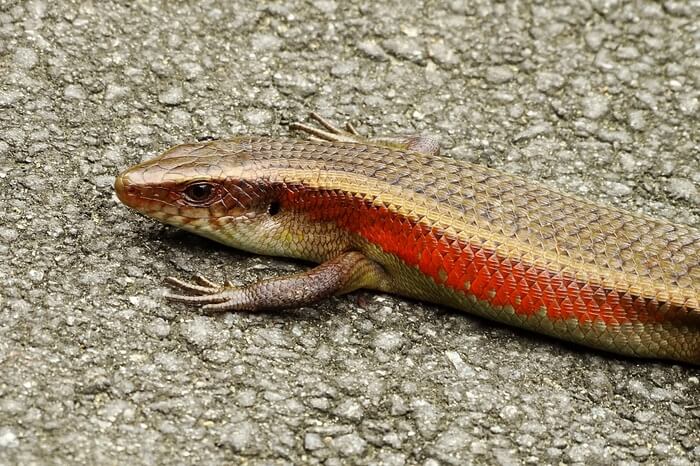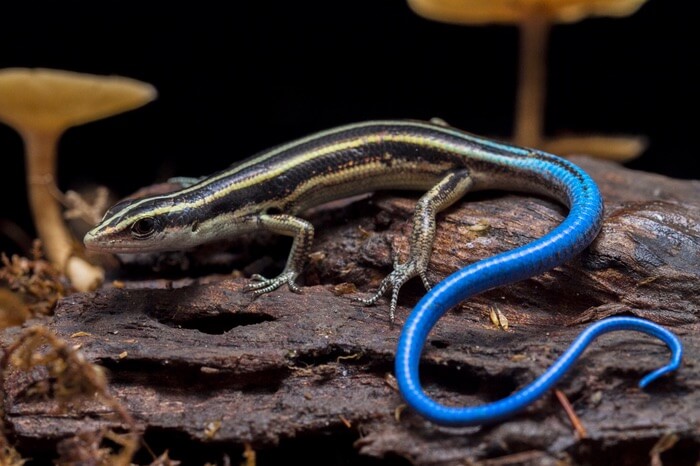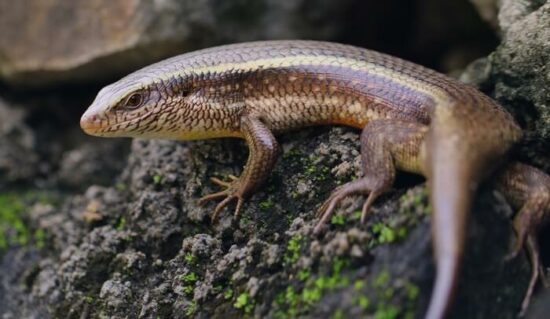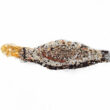Knowing how to get rid of skinks in your house can be quite handy if you find these lizards confusing your home with theirs. But even though the process isn’t hard, many people have no clue where to begin!
This guide will teach you how to get rid of skinks, and keep them away.
Table of contents
What Are Skinks?
Skinks are unique little reptiles that have a knack for invading homes. Technically speaking, these lizards can appear anywhere in the world. However, they’re prevalent in coastal areas throughout the United States.
There, skinks will form communal nests and lay eggs to increase the population. While a few stray lizards here and there don’t seem like a huge problem, skink infestations can get out of hand pretty quickly!
Quick Tip: These creatures are often a victim of mistaken identity whenever homeowners run into them. You see, these aren’t your garden-variety lizards like anoles and geckos.
Skinks have a distinct look that closely mimics that of a snake! Their bodies are big and girthy. Not only that, but the tail is long, thick, and tapered. The legs are pretty short, too, which only adds to the confusion.
- Effective On Skinks And Other Pests
- Easy Application and Clean Up
- Extra Concentrated for Long-Lasting Protection
- Natural Ingredients Proven Effective in the Real World
Many skink species have legs that are pretty short relative to their body size and thickness. Pair that with the reduced toes, and you have an oddball reptile that can easily catch you off guard.

Skinks also tend to navigate very differently than traditional lizards. Because their legs are so short and stubby, most species slink around rather than scurry away. At first glance, the movement is almost identical to that of a snake slithering.
When it comes to color, there’s tons of variety out there. More than 1,500 different known skink species exist. Some are muted and take on relatively neutral colors like brown or black. Others have striking color patterns and bright blue tongues that stand out.
The term “skink” refers to a wide range of lizard-like reptiles. While they all have similar features, some are more exotic-looking than others. You might come across well-camouflaged arboreal species that prefer to climb up your walls or a slithering skink with no legs at all. You can get a better idea of the species in your area, but there’s a good chance that several are capable of inhabiting your home.
Are They Dangerous?
Here’s the good news:
For the most part, skinks aren’t dangerous. Despite their snake-like appearance, these lizards don’t pose an immediate threat to your safety.
Many homeowners panic when they first see these little reptiles, and it’s not hard to see why. The worry is perfectly reasonable with brightly colored species.
Bright colors often indicate a venomous nature. Luckily, that’s not the case with skinks. In fact, those bright colors make them in high demand in the pet world!
Now, that doesn’t mean that skinks are entirely harmless. These lizards can still cause some trouble.
Skinks can sometimes resort to biting when threatened. That behavior is pretty rare, as most garden skinks would prefer to flee rather than get into a confrontation. However, bites do occur.
Bites rarely cause serious harm, but they can be painful. Plus, they can lead to infection if you don’t take care of the wound. You should never try to handle a skink or catch it with your bare hands. Otherwise, a bite might be in your future.

Another potential issue is the poison. Skins are not venomous, meaning that they don’t have any venom that spreads through a bite. However, some species are poisonous (that means that their bodies are toxic when eaten).
I know what you’re thinking, why would you attempt to eat a skink? Well, it’s not so much you or your kids you have to worry about. It’s your pets!
Dogs, cats, horses, and even birds can attempt to eat these lizards. Animals with a high prey drive are the most likely to chase after a skink. The bright colors, fast movements, and general intrusion of these reptiles make them a high-value prize.
Unfortunately, eating a skink can lead to some severe health complications. In most cases, your pet will experience stomach upsets, vomiting, and maybe diarrhea. Smaller animals or those who ate several skinks, however, might need urgent care from a vet.
Even if your pet doesn’t get sick, there’s always a risk of disease-causing pathogens. This threat applies to humans who touch skinks, too. Like many pests, these lizards can harbor bacteria like E. coli, salmonella, and more.
Quick Tip: Washing your hands after touching a skink is a must!
While there are risks with interacting with skinks, most regard the lizard as a nuisance more than anything else. Some even view them as beneficial.
Skinks in your garden can do a lot to manage bug populations. They can clear pest insects and improve the chances of a healthy harvest in a vegetable garden. In that case, you can just let the lizards do their thing.
It’s when they migrate inside and start multiplying that they become a massive headache! That’s when it’s useful to know how to get rid of skinks.
Where Will You Find Them?
Skinks can end up in almost any part of your house. It all depends on the species.
As we mentioned earlier, most skink problems occur in coastal areas of the United States. However, they can live in environments ranging from hot deserts to empty grasslands.
- Effective On Skinks And Other Pests
- Easy Application and Clean Up
- Extra Concentrated for Long-Lasting Protection
- Natural Ingredients Proven Effective in the Real World
If you live in a rural area, don’t be surprised if you find several types of skinks in your backyard. You might find ground-dwelling species that create nests in decaying plant matter or arboreal ones that make homes in the treetops.
Either way, most skinks like to stay near homes. Many make their way through openings in search of food and water. Once they find it, the lizards will stick around for as long as possible.
You’re more likely to find skinks in spots you don’t frequent too often. They love quiet and secure areas where they won’t be bothered, but they also like to stay close to the light and nearby resources for survival.
The most common places you’ll find skinks are:
- Underneath porches
- Storage sheds
- Garages
- Basements
- Sheltered corners
Skinks are pretty savvy when it comes to staying safe. As a diurnal species, these reptiles are active during the day. They move around to bask in the light and find warmth wherever they can get it.
When the sun sets, however, skinks will find a secure spot to get some shut-eye. They usually set up nests in wall voids, secured surfaces where joints meet, or under door gaps.
Signs They’re In Your House
There are several ways to tell that you have skinks near your house that you might want to get rid of!
In addition to physical sightings, you might find the remnants they leave behind. That includes pieces of shed skin, dropped tails, and poop.
Skink poop has a very distinct look. These lizards urinate and defecate at the same time. As a result, their droppings look like a solid brown pellet with a small white cylinder attached.
It looks strikingly similar to bird feces but with a more solid and defined shape.
Of course, you might also find skink nests. These reptiles love to build nests in human-made structures. The exact design of the nest varies from one species to the next. The ones you find in homes are usually in water-damaged beams or voids behind the wall.
Quick Tip: The interesting thing about skinks is that they use communal nests. You can come across one with up to 30 skinks in it!
How To Get Rid Of Skinks
Eager to learn how to get rid of skinks? Lucky for you, there are many ways to control the population and drive them out successfully.
Here are some of the most effective methods worth trying.
1. Remove Their Food Sources
The first thing you should do when getting rid of skinks is deprive them of their food source. While that sounds easy enough, skinks are not like cockroaches or mice. They typically do not eat human food. Instead, they prefer a diet of bugs!
An underlying bug problem is a surefire way to attract skinks into your home. Take a look around to spot the problem. Once you find the bugs that the skinks are feeding on, you can exterminate them.
When the bugs are gone, the skinks will migrate elsewhere to find food.
Skinks can eat a wide variety of bugs, and the problem insect varies based on your climate. In warm and humid areas, skinks usually feed on silverfish, spiders (getting rid of spiders in your garage is highly recommended), pillbugs, and more. In colder areas, the bugs of choice are moths, fleas, and flies.
Quick Tip: Don’t forget to pay attention to areas outside of your house as well. Many bug infestations occur underneath porches or around exterior lighting by a deck. If the skinks are feeding on bugs close to your house, it’s only a matter of time before they move inside.
2. Eliminate Sources Of Water
Like all living creatures, skinks need water to survive. Removing their prime source of hydration can do a lot to keep skinks away from your house.
However, the tricky thing is that skinks don’t need a ton of water. As a result, you have to be extra vigilant about keeping things dry.
Pay attention to how water accumulates inside and outside your house. Outside, you might see stagnant puddles form after a heavy rain. Or, you might have a bird feeder or a leaky sprinkler.
Whatever the case may be, remove it! Getting rid of skinks is a piece of cake when they don’t have any water nearby. They’ll typically vacate on their own.
The same goes for inside water sources. Close toilet covers, fix leaking pipes, and don’t leave water out for too long. You’d be surprised by what sources are supporting the skink population.
Quick Tip: Don’t forget to check appliances like your air conditioner. Condensation is more than enough to keep skinks alive.
3. Tidy Up
Another effective way to get rid of skinks is to keep things clean. Whether the lizards are calling your porch home or they’re living in your garage, there’s likely some comforting and protective clutter in the vicinity.
Many species like to use plant debris to create nests. Those living inside can also use things like scraps of paper, dust, and anything else they can find.
Removing some of the mess will repel skinks by making them look elsewhere for shelter. Not only that, but tidier homes attract fewer bugs for the skinks to eat.
Don’t stop at sweeping and vacuuming. Go the extra mile and clean all of those discreet hiding spots. Take a look around and seal up any holes or voids.
The goal is to make your home as uncomfortable and uninhabitable to skinks as possible. With regular cleaning, there’s a lot less mess that they can take advantage of.
4. Keep It Dark
Believe it or not, reducing light can work wonders if you want to get rid of skinks in your house or yard.
There are a couple of reasons for this. First, light attracts bugs. Have you ever taken a look at your porch light in the dead of night? Chances are, it gets covered in bugs!
It might as well be a buffet for skinks! Limiting the light will draw in fewer insects and give those reptiles fewer opportunities to eat.
Secondly, skinks tend to gravitate towards light naturally. Remember, they need to find heat to thermoregulate. Light indicates warmth, so most skinks will meander towards distant light for shelter.
Start by trying to keep unused lights off if you want to get rid of skinks. The worst offenders are porch and garage lights, but even decorative lighting can be a problem.
5. Use A Repellent
One of the most directly effective methods for getting rid of skinks is spraying repellent.
Repellents are surprisingly effective against skinks. Many commercial products are available. Some of the most commonly used come in the form of concentrated liquid.
All you have to do is attach the concentrate bottle to your hose, crank up the water, and start spraying your yard. It automatically mixes, allowing you to cover your home’s perimeter.
Alternatively, you can pick up in-house sprays. For the most efficiency, spray the product around areas of your home where skinks might live. Pay attention to voids, hidden corners, and other possible nesting areas.
Repellents are relatively harmless, so don’t feel bad about using them. Most include intense aromas that naturally repel skinks. All-natural sprays might utilize pungent essential oils, spices, and aromatic herbs. However, chemical-based products are available, too.
Quick Tip: Insect-based repellents work great as an indirect method as well. Skinks only go where they can find food. If you use repellent to keep bugs away, the skinks will move out in no time.
Preventing Them From Coming Back
Keeping skinks away from your house is an ongoing process. While you can address larger infestations quickly, these reptiles can always come back.
Your best bet to avoid future issues is to keep your property as bug-free as possible. Use repellents and insecticides regularly.
Adopt a routine cleaning schedule and maintain a tidy home and yard. Make your domain unappealing to these lizards, and they won’t even consider moving in. It requires some vigilance and patience, but a little work and can do a lot to deter skinks.
Conclusion
As you can see, getting rid of skinks isn’t a very complex process. All it takes is a bit of knowledge and effort!
We hope you found this guide helpful and have success with your skink problem. If you have any questions about the information above, feel free to let us know.



